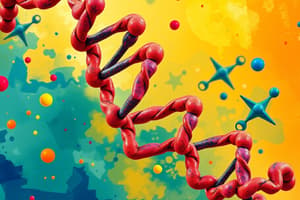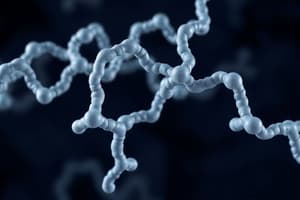Podcast
Questions and Answers
What percentage of protein digestion is completed by pepsin in the stomach?
What percentage of protein digestion is completed by pepsin in the stomach?
- 5-10%
- 10-20% (correct)
- 25-30%
- 50-60%
Pepsin functions optimally at a pH of 4.5-5.5.
Pepsin functions optimally at a pH of 4.5-5.5.
False (B)
What is the role of hydrochloric acid in protein digestion?
What is the role of hydrochloric acid in protein digestion?
It denatures proteins and converts pepsinogen to pepsin.
Pepsin breaks down proteins into __________ of various lengths and some __________.
Pepsin breaks down proteins into __________ of various lengths and some __________.
Match the following enzymes with their function:
Match the following enzymes with their function:
Which type of peptidase cleaves one amino acid at a time from the amino terminus of a polypeptide?
Which type of peptidase cleaves one amino acid at a time from the amino terminus of a polypeptide?
Denaturation of proteins can occur due to the action of heat, alkaline substances, and alcohol.
Denaturation of proteins can occur due to the action of heat, alkaline substances, and alcohol.
What are the final products of protein digestion that are absorbed by enterocytes?
What are the final products of protein digestion that are absorbed by enterocytes?
What can denature a protein?
What can denature a protein?
The primary structure of a protein is altered during denaturation.
The primary structure of a protein is altered during denaturation.
What are the main components that make up amino acids?
What are the main components that make up amino acids?
____ amino acids cannot be synthesized by the human body and must be obtained from the diet.
____ amino acids cannot be synthesized by the human body and must be obtained from the diet.
Match the type of amino acid classification with their description:
Match the type of amino acid classification with their description:
Which of the following is an example of a nonessential amino acid?
Which of the following is an example of a nonessential amino acid?
All 300 amino acids found in nature are used for protein synthesis in humans.
All 300 amino acids found in nature are used for protein synthesis in humans.
What happens to the -COOH group of an amino acid at physiological pH?
What happens to the -COOH group of an amino acid at physiological pH?
What role do aminopeptidases and carboxypeptidases play in the absorption of proteins?
What role do aminopeptidases and carboxypeptidases play in the absorption of proteins?
Hartnup disease and cystinuria are acquired disorders that affect amino acid transport.
Hartnup disease and cystinuria are acquired disorders that affect amino acid transport.
Name the peptide transporter that requires H+ for the active transport of di- and tripeptides.
Name the peptide transporter that requires H+ for the active transport of di- and tripeptides.
In the case of cystinuria, there is an issue with the absorption of ______ amino acids.
In the case of cystinuria, there is an issue with the absorption of ______ amino acids.
Match the following transport mechanisms with their function:
Match the following transport mechanisms with their function:
How many amino acid transporters are present on the basolateral membrane?
How many amino acid transporters are present on the basolateral membrane?
Transport of individual amino acids across the basolateral membrane requires cotransport with sodium ions.
Transport of individual amino acids across the basolateral membrane requires cotransport with sodium ions.
What are the two types of transport processes for amino acids at the basolateral membrane?
What are the two types of transport processes for amino acids at the basolateral membrane?
Flashcards
Protein Digestion in Stomach
Protein Digestion in Stomach
Initial breakdown of proteins into smaller peptides and some amino acids, primarily by pepsin.
Hydrochloric Acid's Role
Hydrochloric Acid's Role
Denatures proteins and converts pepsinogen to pepsin, crucial for protein digestion in stomach.
Pepsin Action
Pepsin Action
An enzyme that breaks down proteins into peptides of varying lengths and some amino acids, acting optimally in a specific pH range.
Pepsin Optimum pH range
Pepsin Optimum pH range
Signup and view all the flashcards
Protein Denaturation
Protein Denaturation
Signup and view all the flashcards
Proteolytic Enzymes
Proteolytic Enzymes
Signup and view all the flashcards
Small Intestine Proteases
Small Intestine Proteases
Signup and view all the flashcards
Peptidases
Peptidases
Signup and view all the flashcards
Denaturing
Denaturing
Signup and view all the flashcards
Denaturing Agents
Denaturing Agents
Signup and view all the flashcards
Protein Shape
Protein Shape
Signup and view all the flashcards
Primary Structure
Primary Structure
Signup and view all the flashcards
Amino Acid
Amino Acid
Signup and view all the flashcards
Peptide Bond
Peptide Bond
Signup and view all the flashcards
Essential Amino Acids
Essential Amino Acids
Signup and view all the flashcards
Protein Function
Protein Function
Signup and view all the flashcards
Amino Acid Transport at Basolateral Membrane
Amino Acid Transport at Basolateral Membrane
Signup and view all the flashcards
Intestinal Peptide Transport
Intestinal Peptide Transport
Signup and view all the flashcards
Brush Border Peptidases
Brush Border Peptidases
Signup and view all the flashcards
Basolateral Amino Acid Transporters
Basolateral Amino Acid Transporters
Signup and view all the flashcards
Hereditary Amino Acid Transport Disorders
Hereditary Amino Acid Transport Disorders
Signup and view all the flashcards
Hartnup Disease
Hartnup Disease
Signup and view all the flashcards
Cystinuria
Cystinuria
Signup and view all the flashcards
Peptidases and Protein Breakdown
Peptidases and Protein Breakdown
Signup and view all the flashcards
Study Notes
Proteins and Amino Acids
- Proteins are polymers of amino acids linked by peptide bonds.
- Amino acids contain carbon, hydrogen, oxygen, nitrogen, and sometimes sulfur.
- The presence of nitrogen distinguishes proteins from carbohydrates and lipids.
- Proteins are categorized based on the number of amino acids in their chain.
- Proteins have four structural levels: primary, secondary, tertiary, and quaternary.
- Protein properties include molecular size, solubility, electrical charge, adsorption to inert materials, and binding to other molecules (antibodies, coenzymes, hormones).
- Amino acids are the building blocks of proteins (approximately 20 unique types).
- Nine amino acids are essential (must be consumed in the diet) and eleven are non-essential (synthesized by the body).
- Some amino acids can be considered conditionally essential, depending on the individual's health state.
- Amino acids consist of a central carbon atom bonded to a hydrogen, carboxyl group, an amino group, and a unique side chain (R group).
- The R group varies among amino acids, leading to diverse properties.
- Different side chains determine protein folding and function.
- Peptide bonds form between the carboxyl group of one amino acid and the amino group of another.
- Condensation creates peptide bonds and releases water.
- Hydrolysis breaks the peptide bonds using water.
- Denaturing of proteins occurs through heat, acids, bases, salts, or mechanical agitation.
- Denaturing alters the protein's shape and thus its function.
- Protein digestion begins in the stomach with pepsin.
- Pepsin breaks down proteins into smaller peptides and amino acids.
- Proteolytic enzymes function in digestion by hydrolyzing peptide bonds.
- Trypsinogen and chymotrypsinogen (proenzymes) are secreted by the pancreas and activated in the small intestine.
- Endopeptidases cleave peptide bonds within the protein; exopeptidases cleave amino acids from the ends of peptide chains.
- Di- and tripeptides are actively transported into enterocytes using a specific transporter.
- Individual amino acids can be transported across the basolateral membrane independently or require cotransport carriers.
- Proteins in the digestive tract are hydrolyzed to individual amino acids for absorption.
- Diseases associated with protein absorption include Hartnup disease and cystinuria.
- Clinical significance of protein levels lies in identifying diseases (such as kidney disease, liver disease, malnutrition) or assessing hydration status and inflammatory processes.
- Examples of clinically important plasma proteins include albumin, alpha-1-acid glycoprotein, ceruloplasmin, C-reactive protein, complements, and immunoglobulins.
Methods of Protein Testing
- Biuret method involves the reaction between peptide bonds and copper ions to measure total protein.
- Direct photometric methods use UV light absorption at specific wavelengths to measure protein concentration, dependent on the aromatic amino acids, tyrosine and tryptophan.
- Dye-binding methods utilize dyes' binding capacity for protein measurement, mainly in CSF and urine samples.
- Turbidimetric and Nephelometric methods quantify protein via precipitation, measuring the turbidity (or light scattering) created.
- Techniques for serum albumin testing involve dye-binding, salt fractionation, electrophoresis, and immunochemical techniques.
- BCG (a dye) method is specific for albumin, determined at pH 4.2.
- Normal serum albumin range for adults is 3.5-5.0 g/dL.
- Methods for determining total globulins utilize colorimetric methods, difference measurement from total protein, electrophoresis, and immunochemical techniques.
Functions of Proteins
- Proteins are crucial in constructing body tissues and structures, catalyzing biochemical reactions, regulating metabolism, protecting against foreign substances, maintaining osmotic balance, transporting molecules, and promoting hemostasis.
- Proteins can be converted to carbohydrates, and some crucial hormones such as thyroid hormones, epinephrine, and norepinephrine are formed from proteins.
Clinical Significance of Protein Testing
- Elevated protein levels may arise from dehydration; decreased levels may indicate edema, inflammatory conditions, kidney disease, malnutrition, or other factors.
- Specific plasma proteins are used in diagnostics to assess conditions such as liver disease.
Diseases Associated with Protein Testing
- Some genetic disorders affect protein transport, causing specific health issues based on the specific proteins affected.
Studying That Suits You
Use AI to generate personalized quizzes and flashcards to suit your learning preferences.




